Investigating Light Hydrocarbon Pipeline Leaks: A Comprehensive Study on Diffusion Patterns and Energy Safety Implications
Abstract
1. Introduction
2. Light Hydrocarbon Pipeline Leakage Dispersion Model
2.1. Conceptual Model of the Light Hydrocarbon Leakage Dispersion Process
2.2. Analysis of Failure Modes and Factors of Light Hydrocarbon Pipelines
2.3. Mathematical Modeling
2.3.1. Basic Equations of Fluid Mechanics
2.3.2. Turbulence Modeling
2.3.3. Modeling of Porous Media
2.4. Physical Modeling
2.4.1. Geometric Configuration
2.4.2. Grid Segmentation and Irrelevance Verification
2.4.3. Boundary Conditions and Model Solving Setup
- (1)
- Boundary condition settingTo ensure accurate and convergent results, all boundary conditions must be defined based on the specific boundaries of the computational model.
- (a)
- Pipeline: The leakage port is defined as a pressure inlet. The outer wall of the pipeline is treated as a non-slip stationary wall. The component boundary condition is set such that the mass fraction or mass flux of light hydrocarbons at the outer wall is zero, preventing inflow through the pipe wall.
- (b)
- Atmosphere: The left boundary is defined as a velocity inlet representing the natural wind, while the top and right boundaries are set as pressure outlets at atmospheric pressure.
- (c)
- Soil: The perimeter and bottom of the soil domain are defined as symmetry boundaries, and the top surface (ground) is defined as an internal interface.
- (2)
- Multiphase flow model setup
2.4.4. Verification of Simulation Accuracy
3. Analysis of the Whole Process of Light Hydrocarbon Pipeline Leakage Diffusion
3.1. Numerical Simulation of the Whole Process of Light Hydrocarbon Pipeline Leakage
- (1)
- The horizontal radius, vertical height, and underground depth of diffusion all stabilize after 800 s, showing rapid early expansion followed by gradual slowing. Liquid hydrocarbons tend to stabilize earlier than gaseous ones, and heavier components stabilize more quickly.
- (2)
- In the early stage, light components diffuse more rapidly than heavy ones. C2 shows a faster initial rate than C3, but due to the higher proportion of C3 in the mixture, its overall diffusion range eventually exceeds that of C2.
- (3)
- C5, as the lightest and most abundant liquid hydrocarbon, exhibits the largest overall diffusion range. As a result, the diffusion behaviors of C3 and C5 are particularly critical for understanding the leakage and dispersion patterns of light hydrocarbons.
3.2. Comparative Analysis of Multi-Component Leakage Versus Single-Component Leakage
- (1)
- When the light hydrocarbon flow rate is controlled to be the same, the diffusion patterns of individual components differ between multi-component and single-component leakage, and the trends are not always consistent.
- (2)
- The diffusion range of C2–C4 is greater in the single-component case, and the difference between single- and multi-component scenarios is particularly notable for C3 and C4. Gaseous diffusion dominates after C2–C4 leakage. However, in the multi-component case, lighter components inhibit the gasification of heavier ones, making the difference in diffusion range more pronounced.
- (3)
- For C5–C8, the diffusion range is greater under multi-component conditions. These components mainly spread as liquid hydrocarbons after leakage, and the presence of gaseous components carries them further, resulting in a slightly larger diffusion range.
- (4)
- Although the diffusion range of C2–C4 is larger in the single-component case, the presence of other components in multi-component leakage can inhibit their gasification, leading to higher concentrations near the leakage orifice. This increases the risk of poisoning and asphyxiation and may also elevate fire and explosion hazards.
4. Influence of Different Factors on the Dispersion Pattern of Light Hydrocarbon Leakage
4.1. Component Ratios
- (1)
- As the proportion of C3 increases, both the maximum horizontal diffusion radius of C3 and the overall diffusion range increase. Meanwhile, the horizontal diffusion ranges of the other components decrease, indicating that C3 content has a strong influence on the overall diffusion behavior.
- (2)
- The horizontal diffusion range of each component increases as its proportion increases, but the increase is more pronounced for gaseous hydrocarbons (C2–C4) than for liquid ones (C5–C8).
- (3)
- With increasing C3 content, the horizontal diffusion radius and vertical diffusion height increase, while underground diffusion depth decreases. In contrast, increasing the proportion of C5 yields the opposite trend. A higher proportion of light components leads to more intense aboveground diffusion, whereas a higher proportion of heavy components promotes deeper subsurface migration.
4.2. Operating Pressure
- (1)
- As pipeline pressure increases, the maximum diffusion range of light hydrocarbons—as well as the horizontal diffusion radius, vertical diffusion height, and underground penetration depth of each component—expands significantly. Consequently, the overall hazardous area increases.
- (2)
- For C3, both the horizontal diffusion radius and vertical diffusion height increase with pressure. However, the marginal effect of increasing pressure gradually diminishes at higher levels.
- (3)
- Pipeline pressure has a greater impact on gaseous hydrocarbons than on liquid ones. Among liquid hydrocarbons, C5 exhibits the most notable increase in diffusion range under higher pressure.
- (4)
- Higher pipeline pressure leads to increased leakage volume, which elevates local concentrations of light hydrocarbons. Given that the diffusion area of interest is defined by the lower explosive limit, greater concentrations result in a broader hazardous zone and more pronounced hydrocarbon aggregation.
4.3. Orifice Orientation
- (1)
- The horizontal diffusion radius is primarily affected by the wind direction and the initial horizontal velocity of the leaked gas. Upward-facing orifices aligned with the wind direction promote horizontal dispersion. Downward-facing orifices, on the other hand, experience greater resistance from the soil, resulting in reduced horizontal spread. When the orifice is oriented directly windward, the horizontal diffusion radius is further reduced due to the opposing wind force, although gas accumulation near the orifice may still occur.
- (2)
- The vertical diffusion height is largely influenced by the vertical component of the initial leakage velocity. Orifices oriented upward produce greater vertical dispersion, with the highest vertical diffusion observed at horizontally upward orientations. Downward orientations, constrained by soil resistance, exhibit significantly reduced vertical dispersion.
- (3)
- Interaction with resistance: The kinetic energy of the escaping hydrocarbons is consumed by resistive forces, which oppose the direction of motion. When the orifice is oriented non-vertically, a horizontal velocity component is introduced, enhancing lateral diffusion. However, diagonal downward orientations result in greater soil resistance, limiting diffusion compared to upward angles. The greatest horizontal spread is observed when the orifice is oriented horizontally to the right, while vertical downward orientations lead to the smallest overall diffusion range due to maximum resistance from the soil.
4.4. Ambient Wind Speed
- (1)
- Horizontal Diffusion: As wind speed increases, the horizontal diffusion radius expands significantly. For instance, C3 increases from 24.0 m to 279.4 m. However, the rate of increase gradually diminishes at higher wind speeds due to growing aerodynamic resistance. C5 shows a more modest increase, from 51.3 m to 78.3 m, indicating that gaseous hydrocarbons are more sensitive to wind speed than liquid ones.
- (2)
- Vertical Diffusion: In contrast, the vertical diffusion height decreases with rising wind speed. For C3, it drops from 115.8 m to 17.8 m, although the rate of decline slows at higher speeds. Since vertical diffusion is evaluated at the lower explosive limit of light hydrocarbons, faster dispersion caused by higher wind speeds leads to a smaller vertical range at the critical concentration threshold.
- (3)
- According to the potential impact radius (PIR) for natural gas transmission pipelines in high consequence areas, the impact radius under the given conditions is approximately 41.9 m. However, when the transported medium is light hydrocarbons, the impact radius is influenced by factors such as component composition and environmental conditions. In particular, the presence of wind can significantly increase the diffusion range. Therefore, for light hydrocarbon pipelines, it is advisable to determine the impact radius based on both environmental factors and the composition of the transported medium.
5. Conclusions
- (1)
- The diffusion of light hydrocarbon leakage exhibits a clear temporal evolution. Initially, the leaked hydrocarbons rapidly disperse, and the primary shape of the diffusion cloud quickly forms. As time progresses, the diffusion range continues to expand, with three main pathways observed: horizontal spreading, vertical upward dispersion, and downward seepage into the subsurface. Gaseous components primarily contribute to horizontal dispersion, while liquid hydrocarbons begin to stabilize within a confined area. Over time, the rate of diffusion gradually slows, and by approximately 800 s after leakage onset, the overall diffusion boundaries reach a relatively stable state. Among the various components, C3 demonstrates the widest gaseous diffusion range, while C5 exhibits the most extensive liquid-phase spread, making them key indicators in assessing leakage severity.
- (2)
- In multi-component systems, vaporization and diffusion follow a sequential order. The vaporization of gaseous components is inhibited by heavier components, resulting in a smaller diffusion range than single-component cases. However, the presence of gas-phase components promotes the spread of liquid hydrocarbons through a carrier effect. Gas accumulation near the leakage point is more prominent under multi-component conditions.
- (3)
- Changes in component proportion affect the diffusion behavior. As the proportion of C3 or C4 increases, their individual diffusion ranges expand, while those of other components may decrease. No consistent pattern was observed for the maximum diffusion range, suggesting a nonlinear interaction dominated by the ratio of C2 to C3.
- (4)
- An increase in pipeline pressure significantly expands the diffusion range and leakage volume. The diffusion extent is positively correlated with internal pressure.
- (5)
- Orifice orientation significantly affects diffusion geometry. Upward and wind-aligned leakage increases horizontal spread and subsurface penetration but reduces vertical height. Downward orientations experience greater soil resistance, limiting horizontal and vertical diffusion while deepening underground penetration. The effects become more pronounced at smaller or larger inclination angles, depending on the wind–leakage alignment.
- (6)
- Ambient wind speed enhances horizontal dispersion but suppresses vertical and subsurface diffusion. As wind speed increases, light hydrocarbons spread further horizontally but aggregate less, reducing the potential for localized high-concentration zones.
Author Contributions
Funding
Data Availability Statement
Conflicts of Interest
References
- Dai, Z. Discussion on the safety distance of oilfield light hydrocarbon transportation pipeline. Electron. Mag. Baike Forum 2021, 5, 471. [Google Scholar] [CrossRef]
- Yue, Y. DOLPHIN-based leakage monitoring for liquefied light hydrocarbon pipelines. Smart Fact. 2016, 1, 86–89. [Google Scholar]
- Wang, J. Application of negative pressure wave technology to detect leakage of light hydrocarbon pipeline. Oil Gas. Field Surf. Eng. 2007, 6, 15–16. [Google Scholar]
- Wang, J.; Li, X.; Sun, K. Field test of anti-theft monitoring technology for negative pressure wave leakage of light hydrocarbon pipeline. Pet. New Energy 2004, 15, 38–39. [Google Scholar] [CrossRef]
- Liang, Y. Research on Transportation Function and Safety of Mixed-Air Light hydrocarbon Gas Pipeline Network. Master’s Thesis, Xi’an Shiyou University, Xi’an, China, 2021. [Google Scholar]
- Qiu, R.; Zhang, H.; Gao, X.; Zhou, X.; Guo, Z.; Liao, Q.; Liang, Y. A multi-scenario and multi-objective scheduling optimization model for liquefied light hydrocarbon pipeline system. Chem. Eng. Res. Des. 2019, 141, 566–579. [Google Scholar] [CrossRef]
- Du, S.; Xue, S.; Zheng, C. Design of leakage monitoring experimental System for urban Gas Transmission and Distribution pipelines. Lab. Res. Explor. 2019, 39, 66–70. [Google Scholar]
- Cao, W.; Yang, D.; Li, X.; Jia, J. A method for monitoring buried pipeline leakage based on SH wave. Press. Vessel. 2023, 40, 16–20, 37. [Google Scholar] [CrossRef]
- Zhu, H.; Lin, Y.; Ma, C. Simulation of leakage and diffusion in gathering and transportation pipelines containing hydrogen sulfide in flat area. J. Southwest. Pet. Univ. 2009, 31, 156–160. [Google Scholar] [CrossRef]
- Bu, F.; Liu, Y.; Chen, S.; Wu, J.; Guan, B.; Zhang, N.; Lin, X.; Liu, L.; Cheng, T.; Shi, Z. Real scenario analysis of buried natural gas pipeline leakage based on soil-atmosphere coupling. Int. J. Press. Vessel. Pip. 2022, 199, 104713. [Google Scholar] [CrossRef]
- Fu, M.; Huang, Y.; Zhang, M.; Zhang, J.; Yang, J.; Yang, M.; Zou, B.; Kou, J.; Liu, J.; Yao, W.; et al. Numerical simulation of leakage and diffusion characteristics of buried natural gas pipeline in tunnel. J. Saf. Environ. 2024, 24, 1105–1113. [Google Scholar]
- Marchioli, C.; Zhao, L. Dispersed multiphase flows: Advances in measuring, simulation and modeling. Acta Mech. Sin. 2022, 38, 1–3. [Google Scholar] [CrossRef] [PubMed]
- Cao, X.; Wang, Q. Simulation of leakage law in gas-liquid two-phase flow pipeline. Oil Gas. Storage Transp. 2017, 36, 969–975. [Google Scholar] [CrossRef]
- Schneiderbauer, S.; Saeedipour, M. The impact of interphase forces on the modulation of turbulence in multiphase flows. Acta Mech. Sin. 2022, 38, 1–11. [Google Scholar] [CrossRef]
- Yan, D.; Jian, S.; Xiao-lin, W.; Lei, S. Study on Methods for Classifying Oil & Gas Pipeline Incidents. China Saf. Sci. J. 2013, 23, 109–115. [Google Scholar] [CrossRef]
- SY/T 6859-2020; Guidelines for Risk Evaluation of Oil and Gas Transmission Pipelines. Petroleum Industry Press: Beijing, China, 2020.
- Xiao, C.; Lu, Z.; Yao, S.; Yan, L.; Wang, J. A CFD computational model for high-pressure liquid CO2 decompression. IOP Conf. Ser. Earth Environ. Sci. 2021, 675, 012205. [Google Scholar] [CrossRef]
- Taheri, A.A.; Maboudi, A.; Khavasi, E.; Taghilou, M. Thermal analysis of disk-type transformer winding immersed in nanofluids using mixture and Eulerian–Lagrangian approach. J. Braz. Soc. Mech. Sci. Eng. 2022, 44, 1–13. [Google Scholar] [CrossRef]
- Wang, J.; Yan, Y.; Li, J. Numerical simulation of methane spreading in porous media after leaking from an underground pipe. Int. J. Numer. Methods Heat. Fluid Flow. 2020, 31, 367–390. [Google Scholar] [CrossRef]
- Chu, F.; Zhang, Y.; Lin, Q.; Zhou, X.; Guo, C. Two-Stream Numerical Simulation of a New Type Drum Dryer. J. Appl. Math. Phys. 2019, 07, 1606–1624. [Google Scholar] [CrossRef]
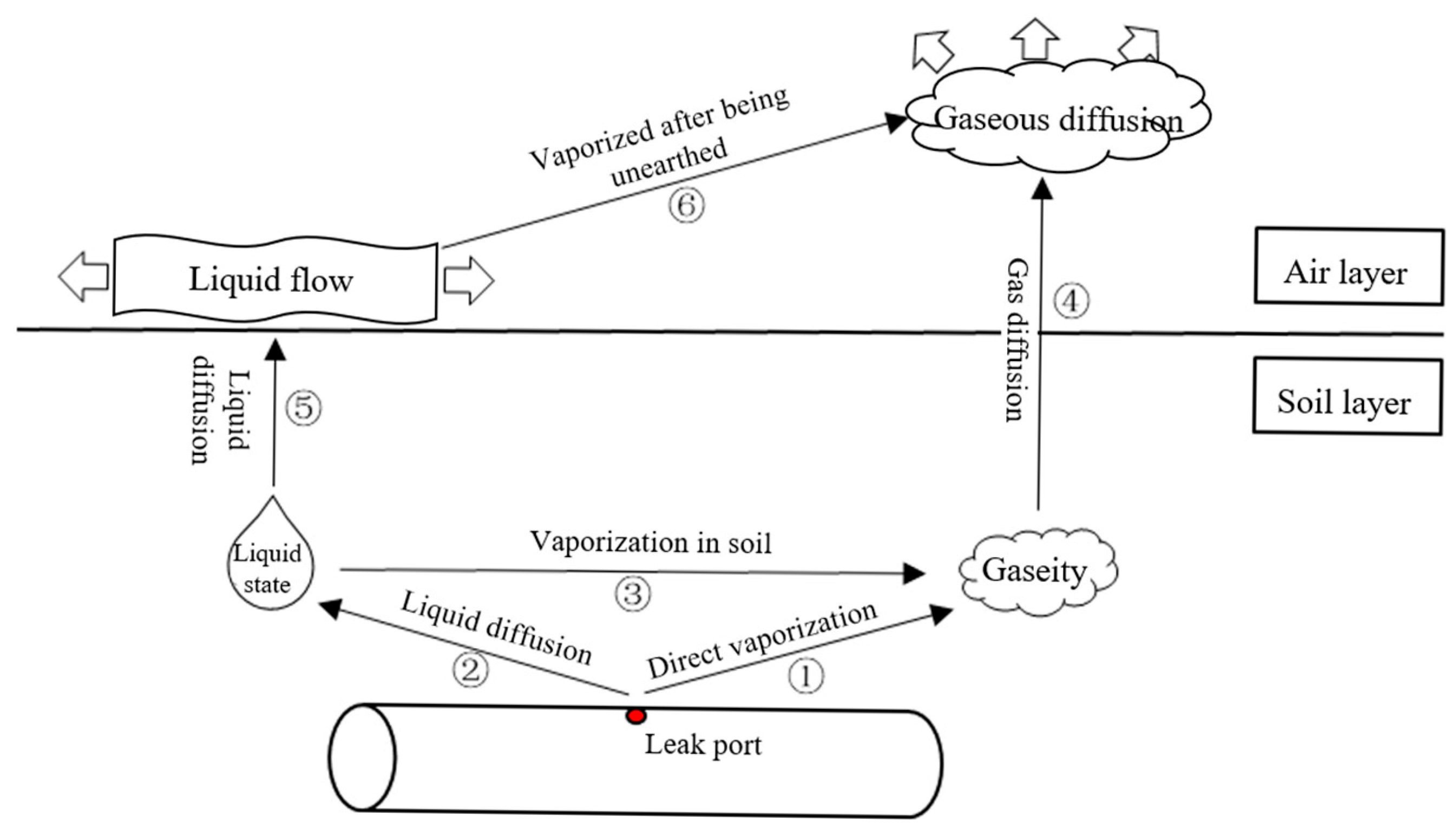
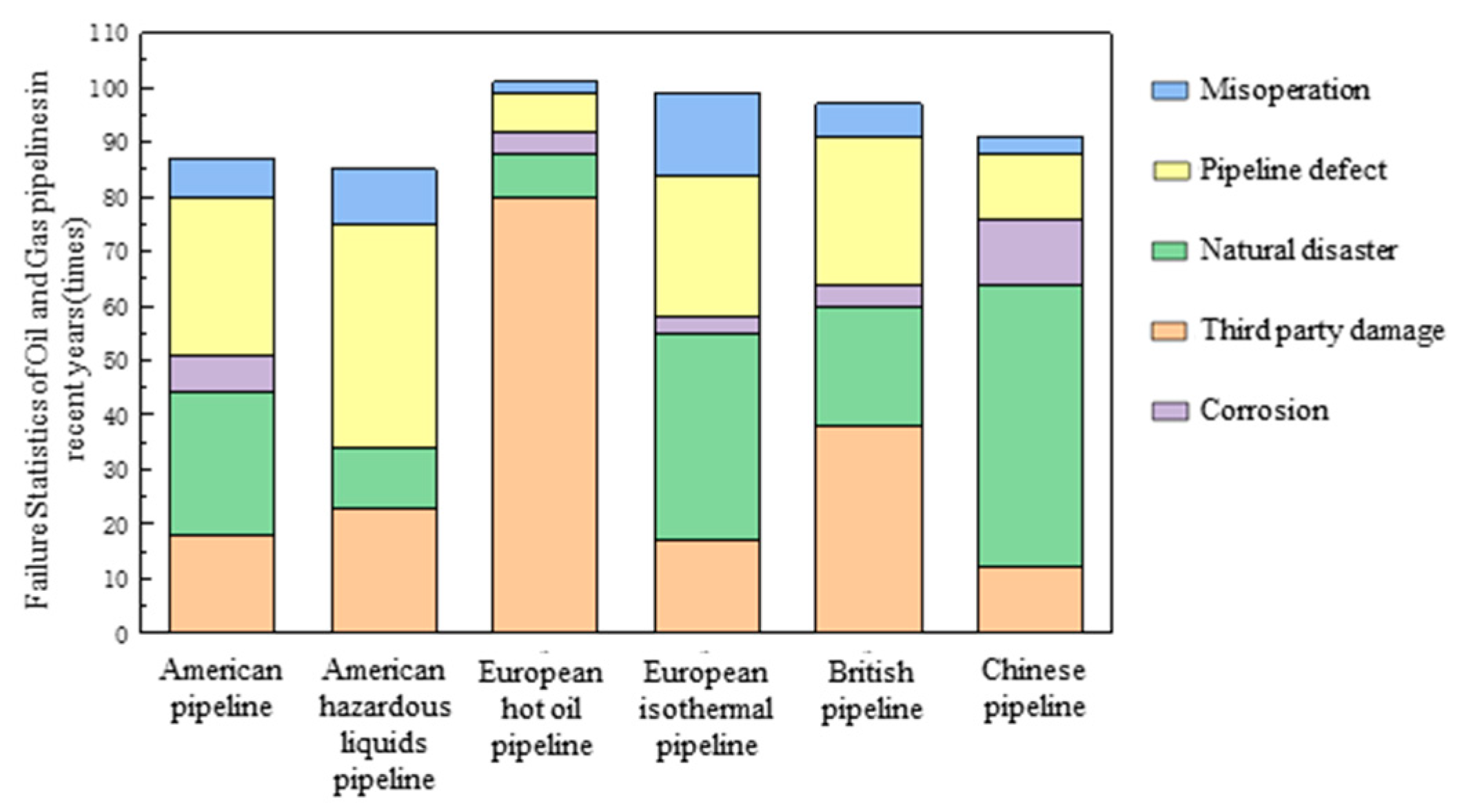
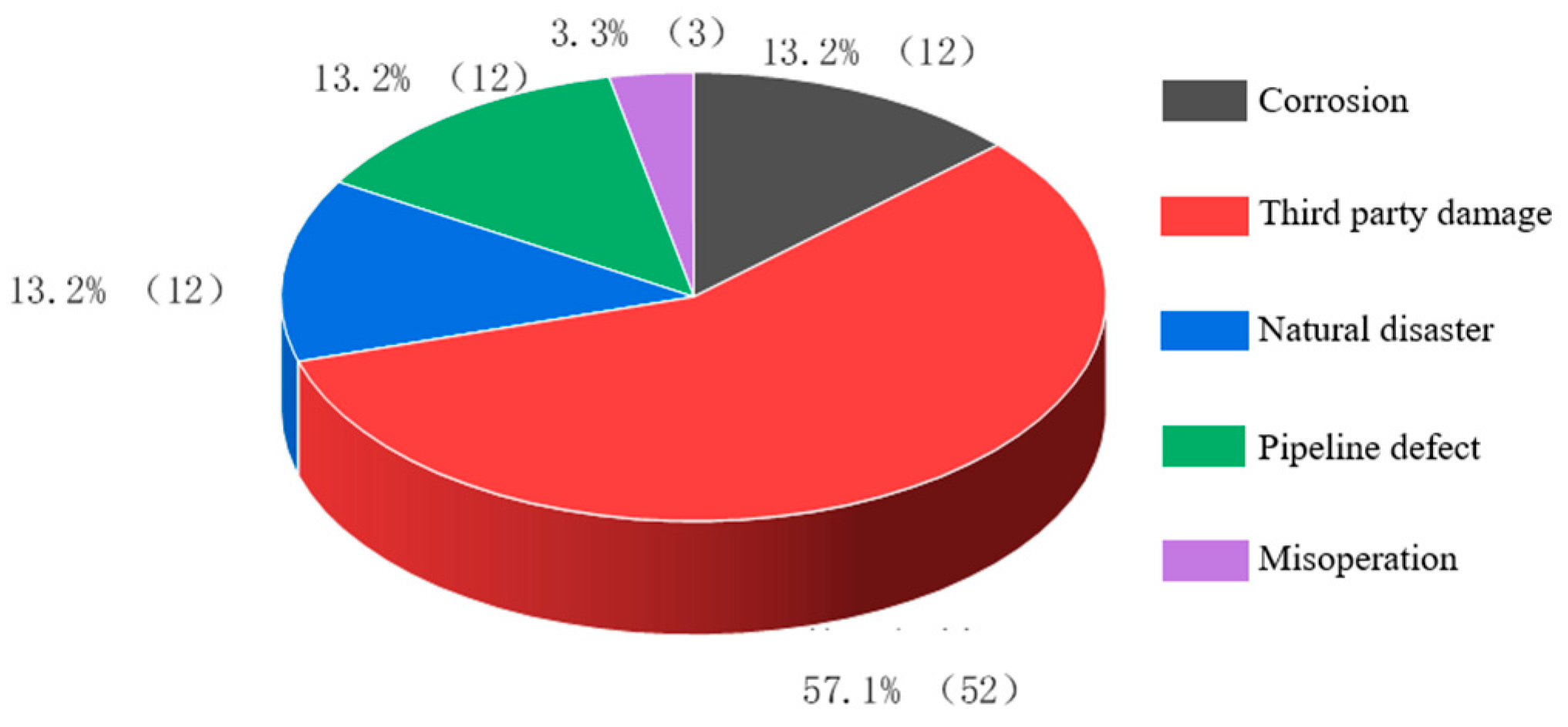
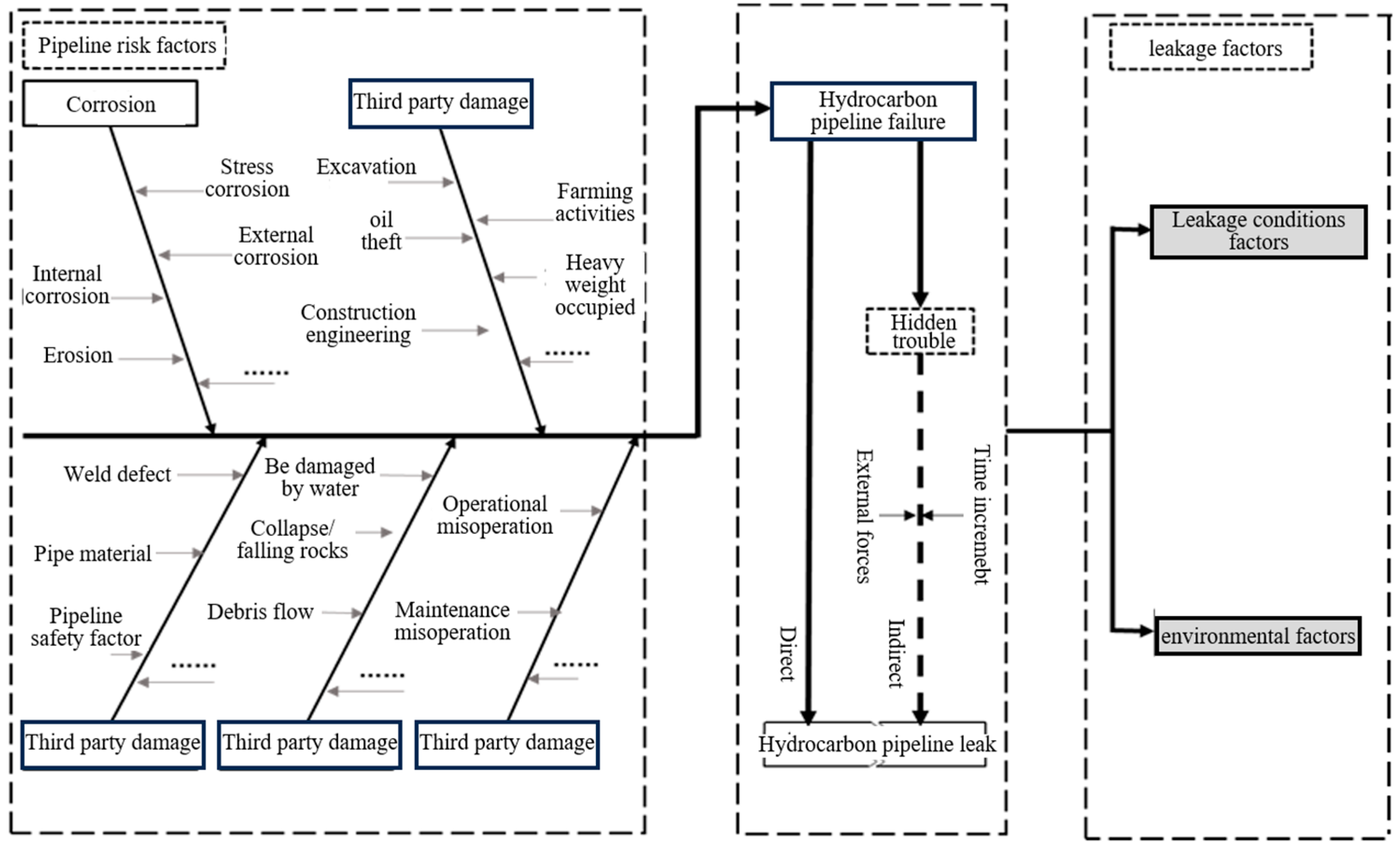
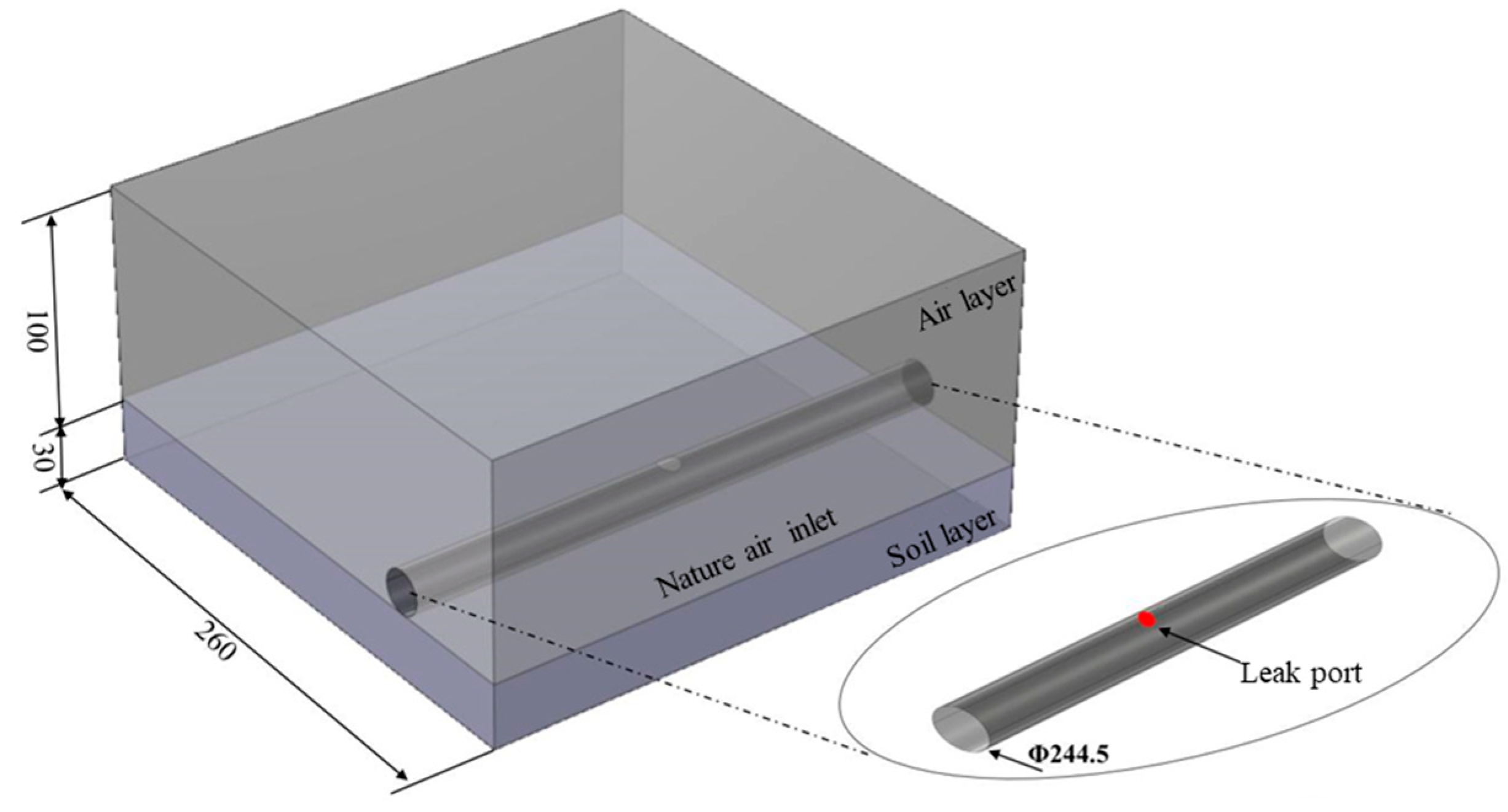
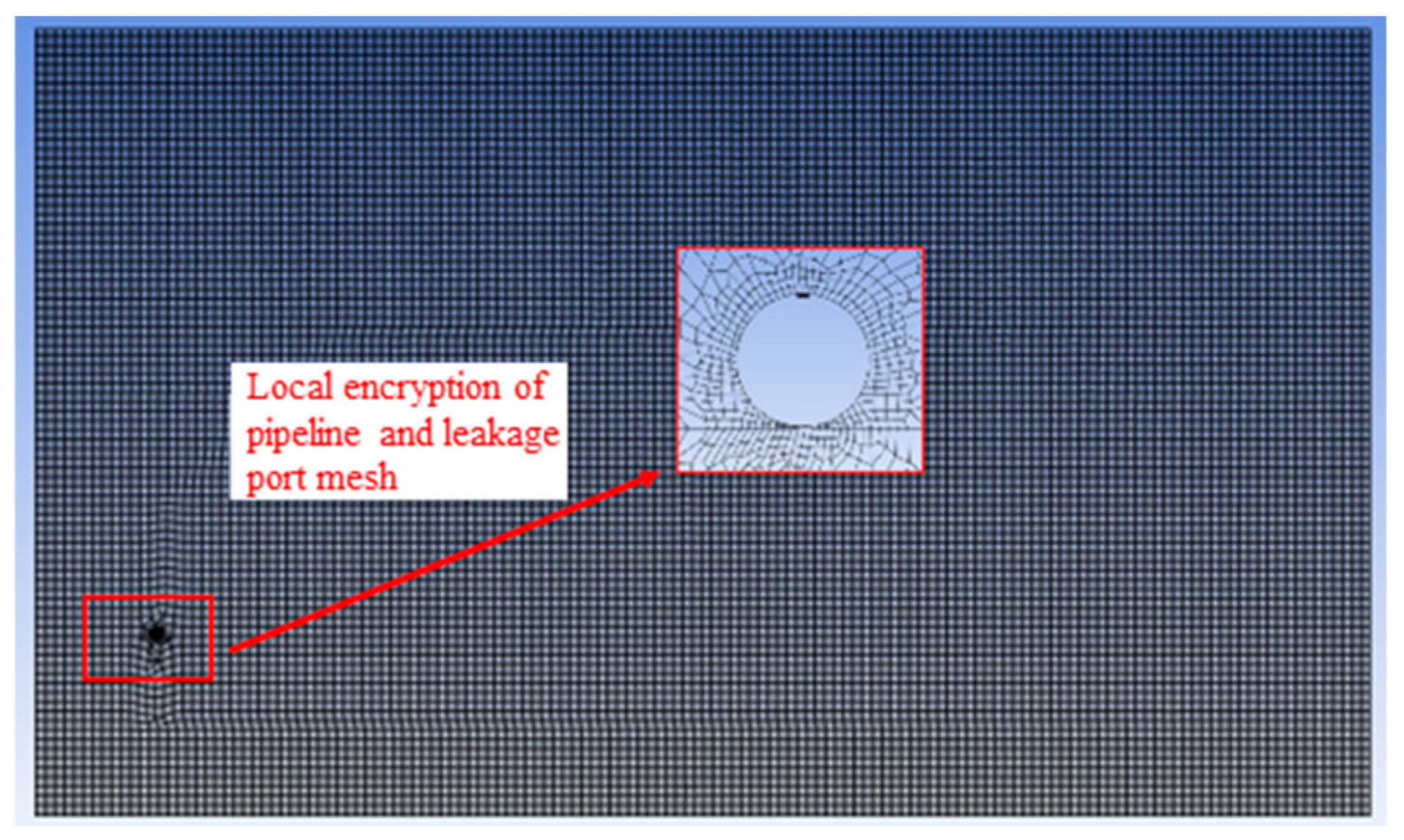
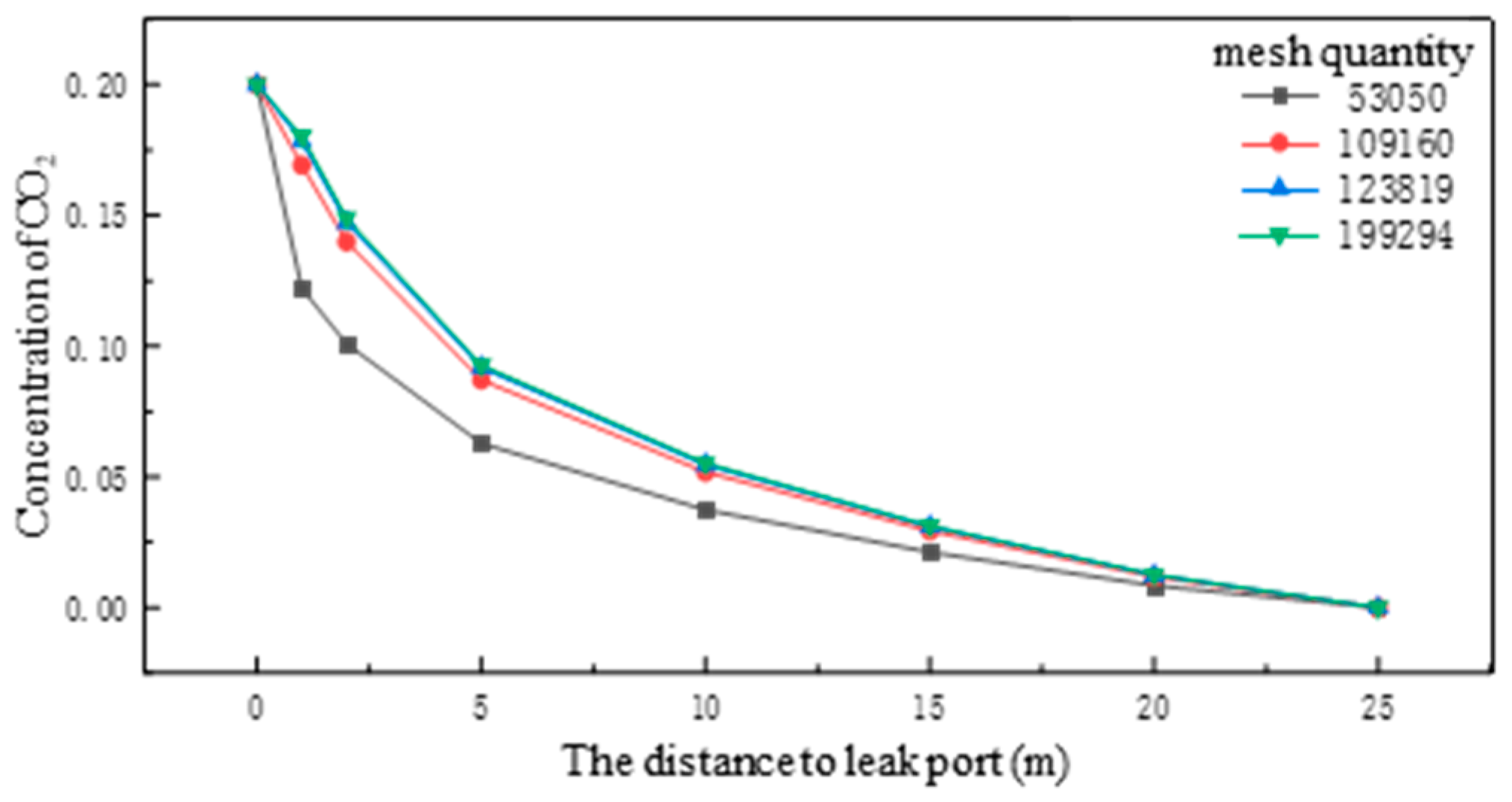
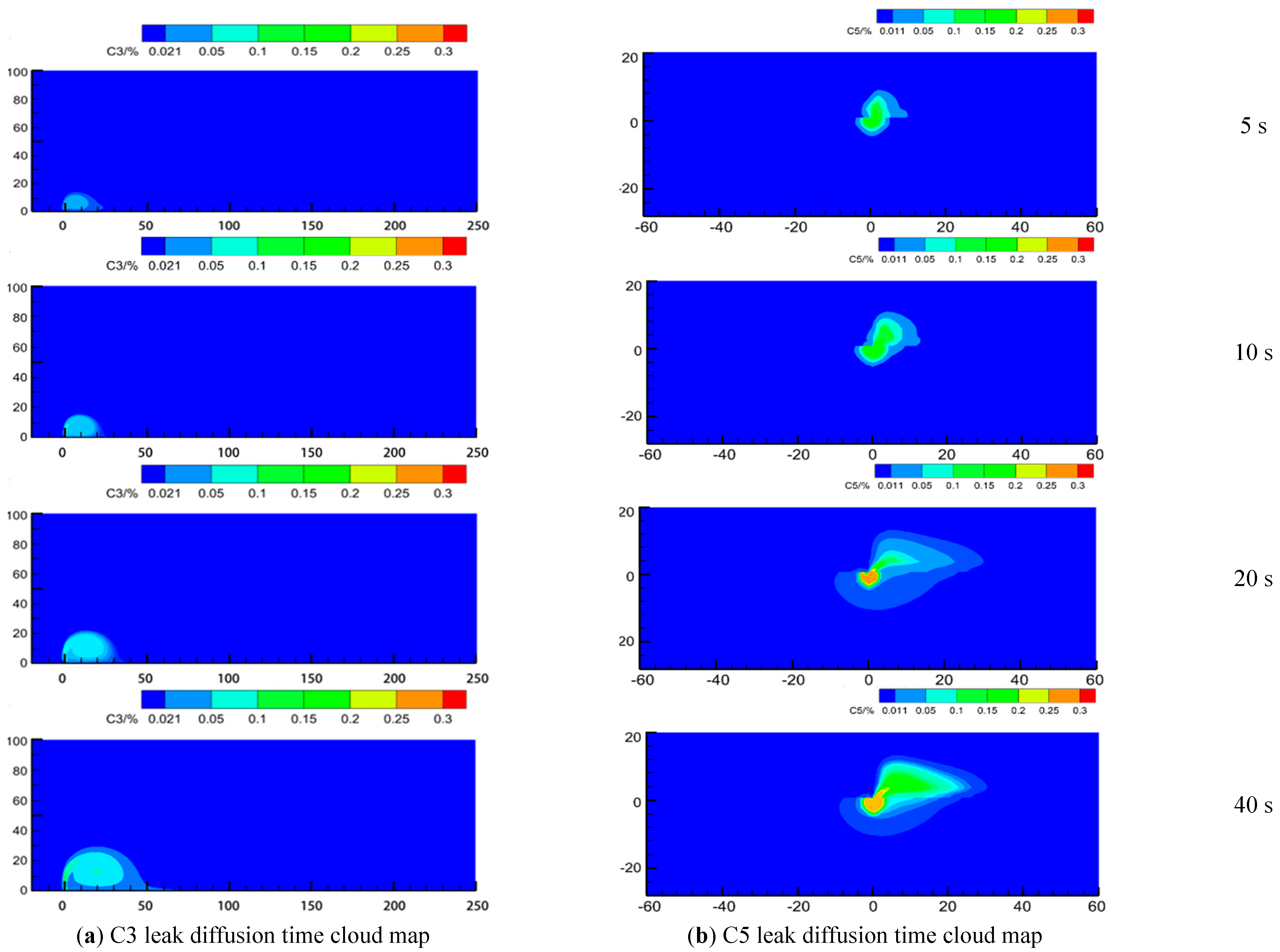
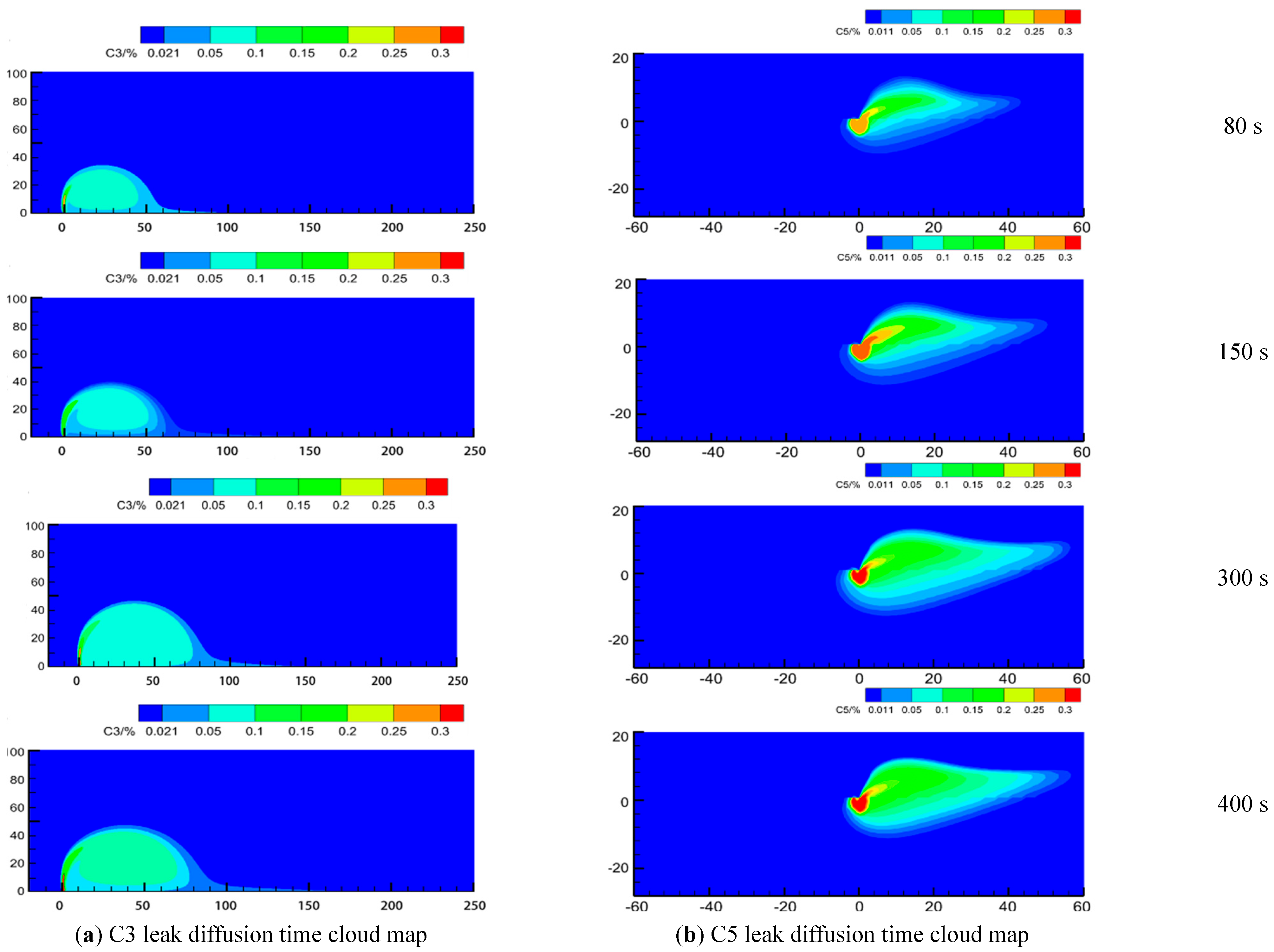
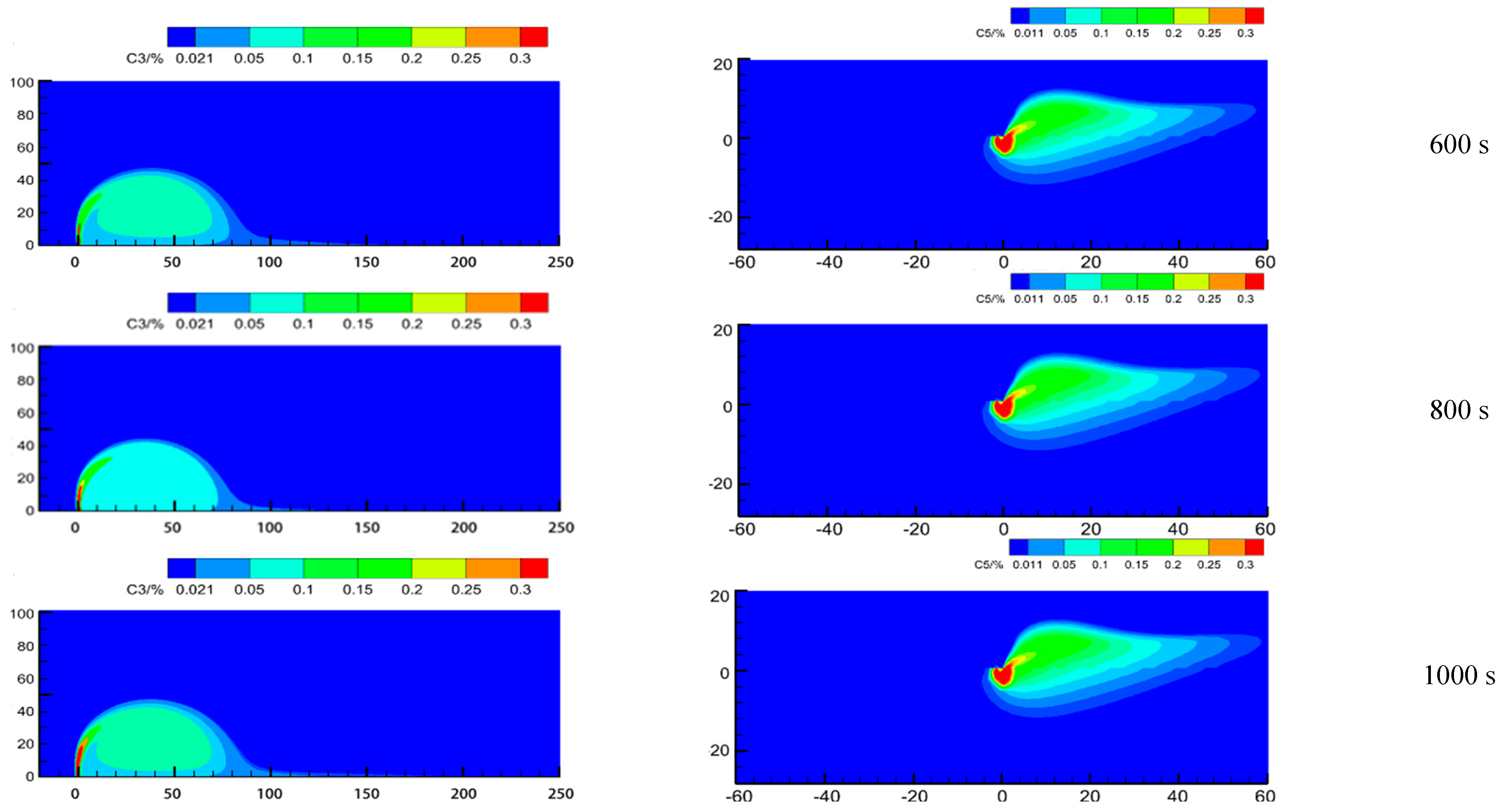

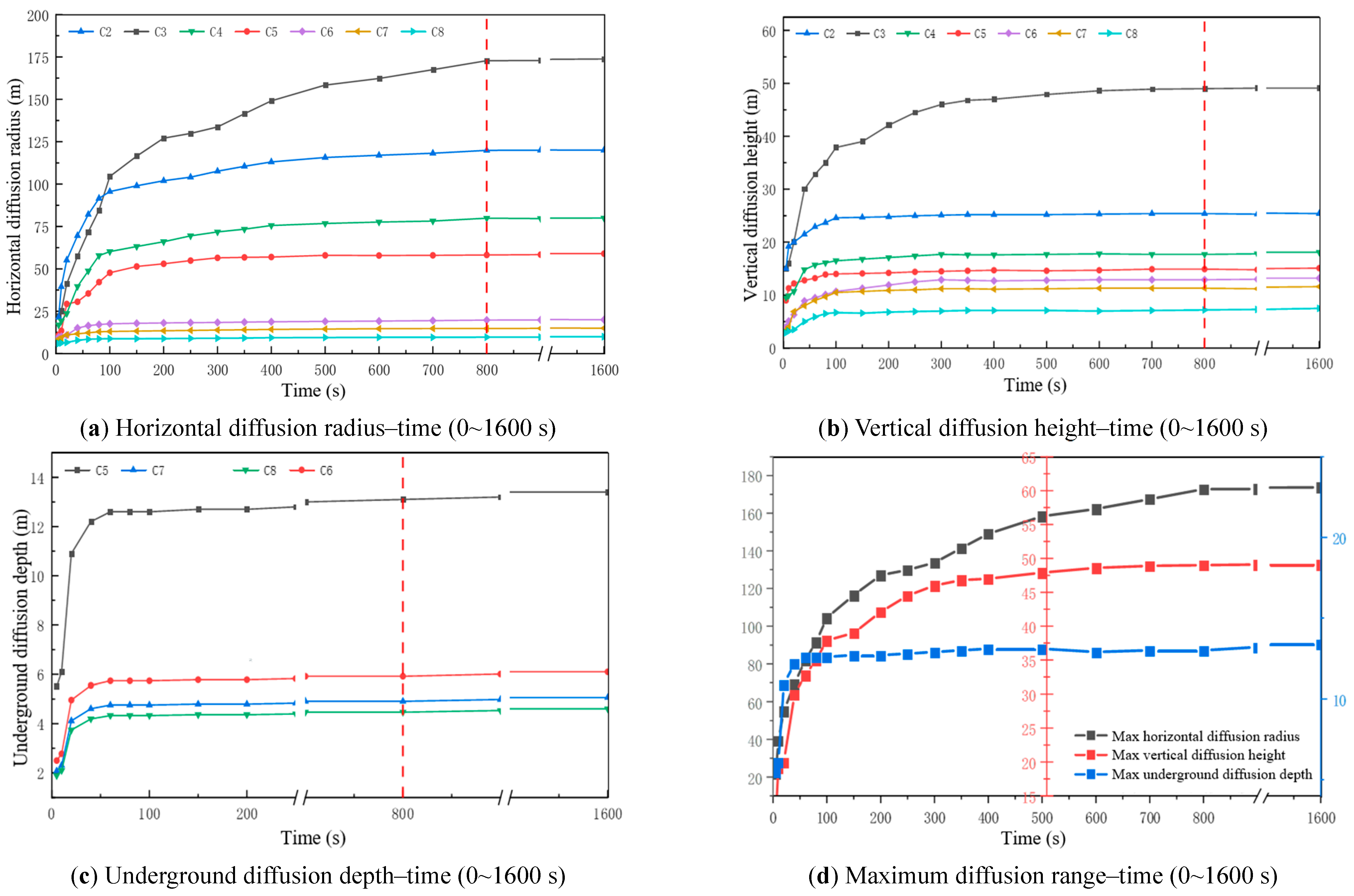
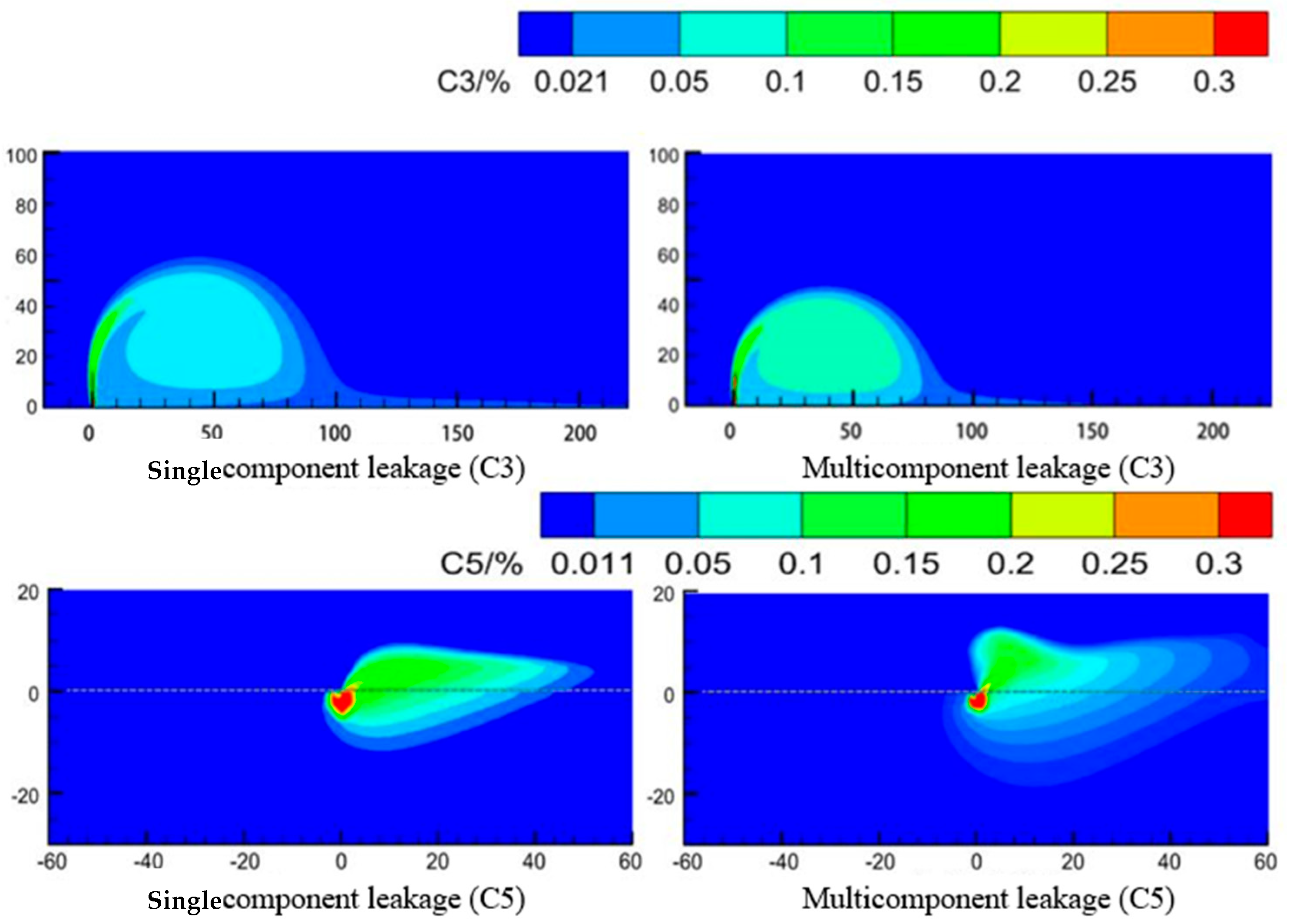
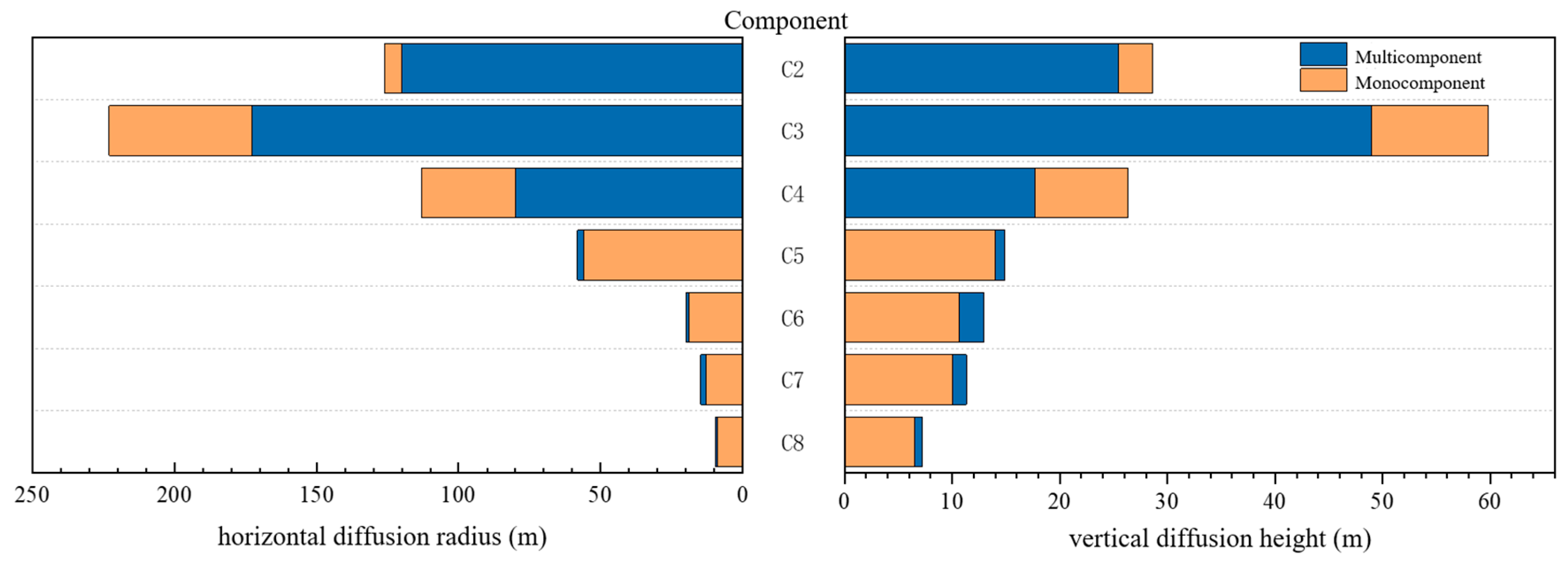


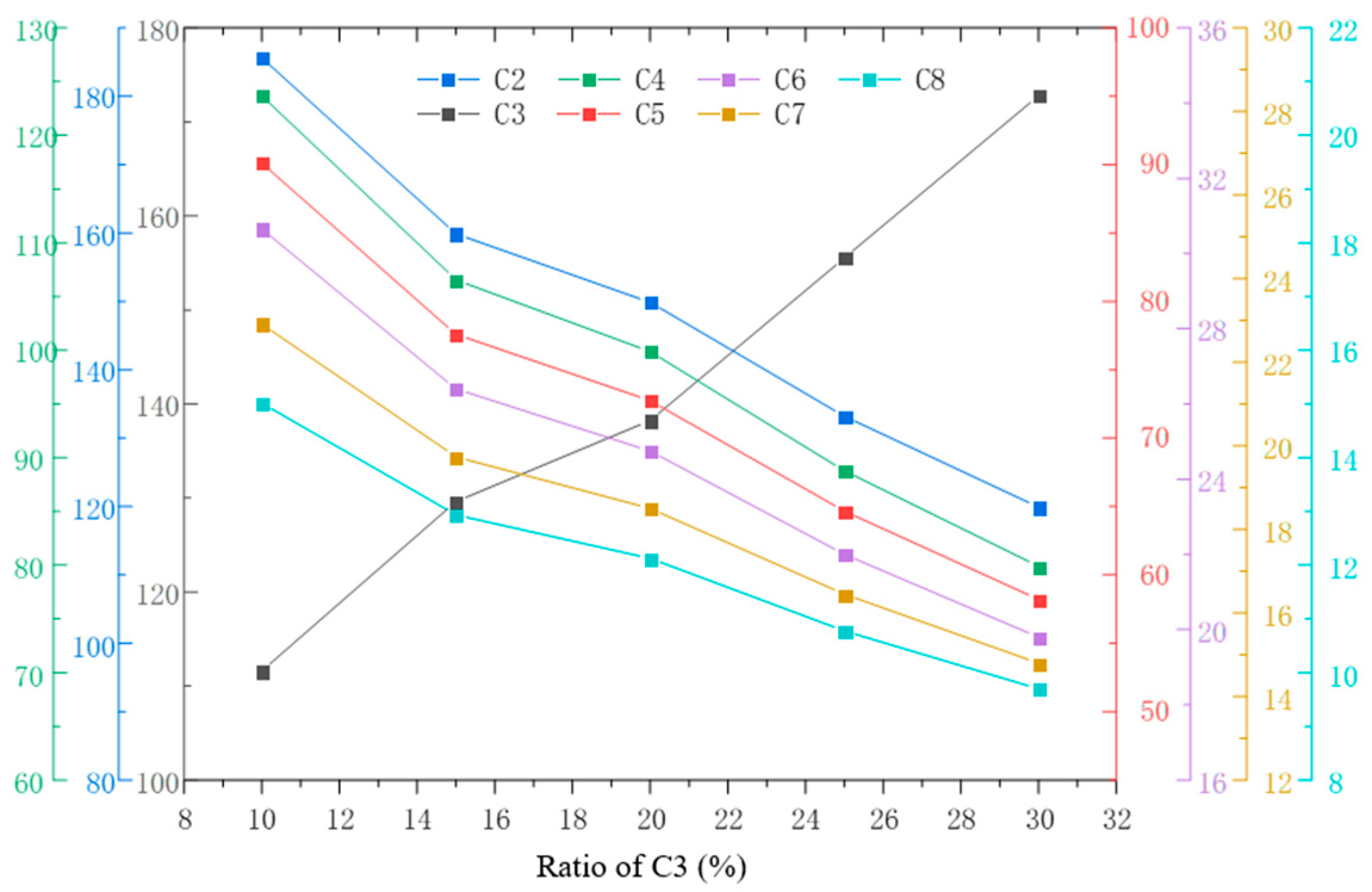

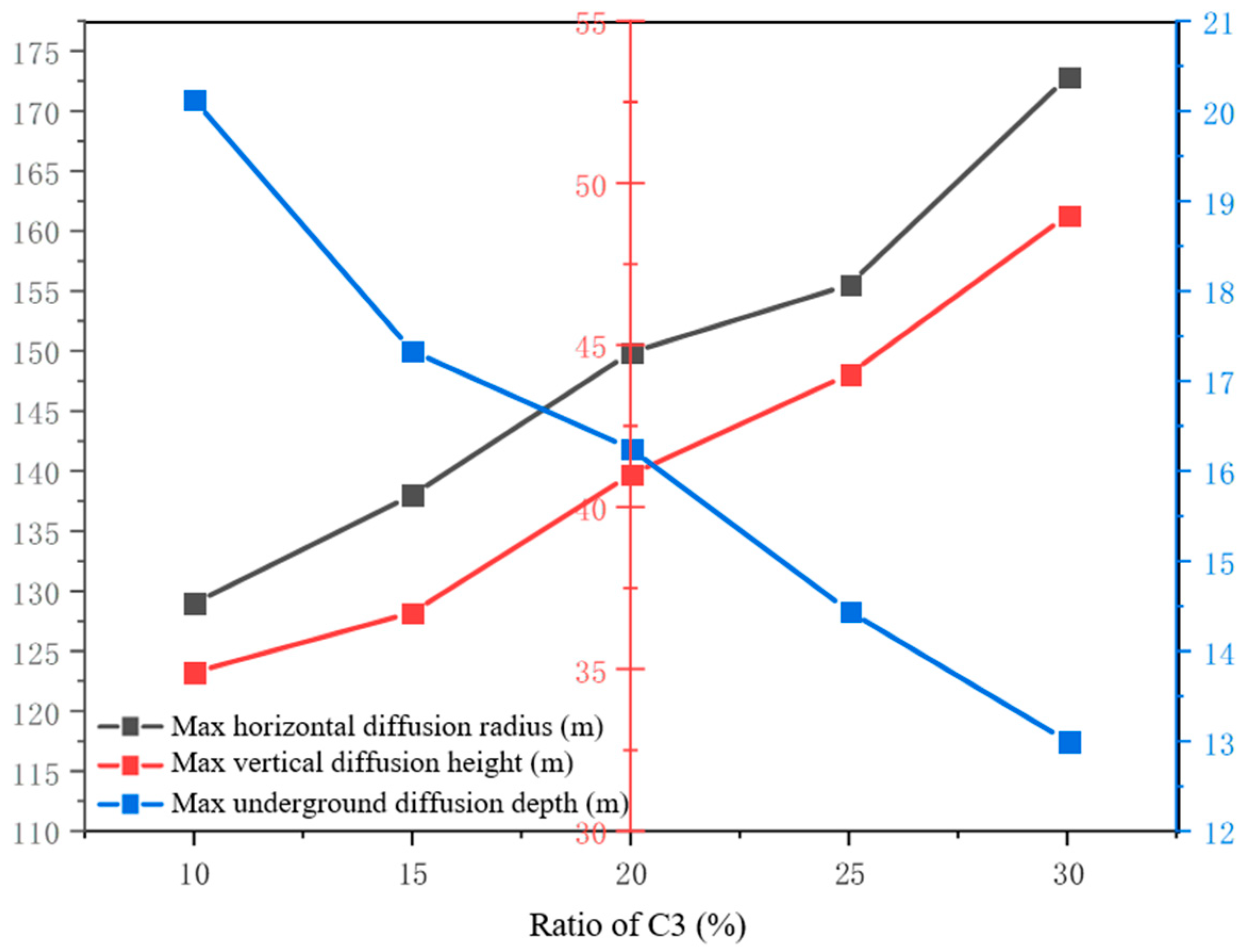
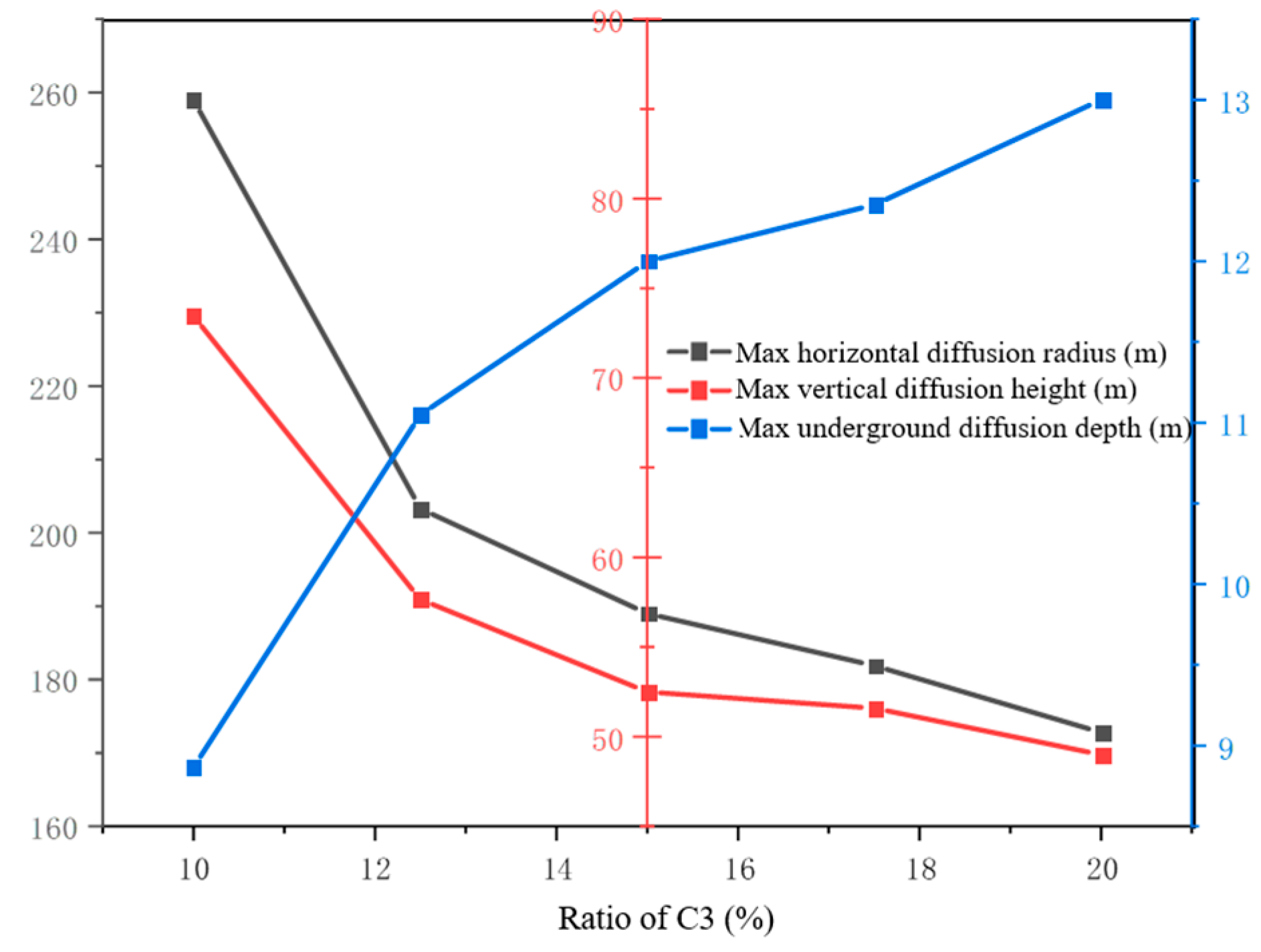


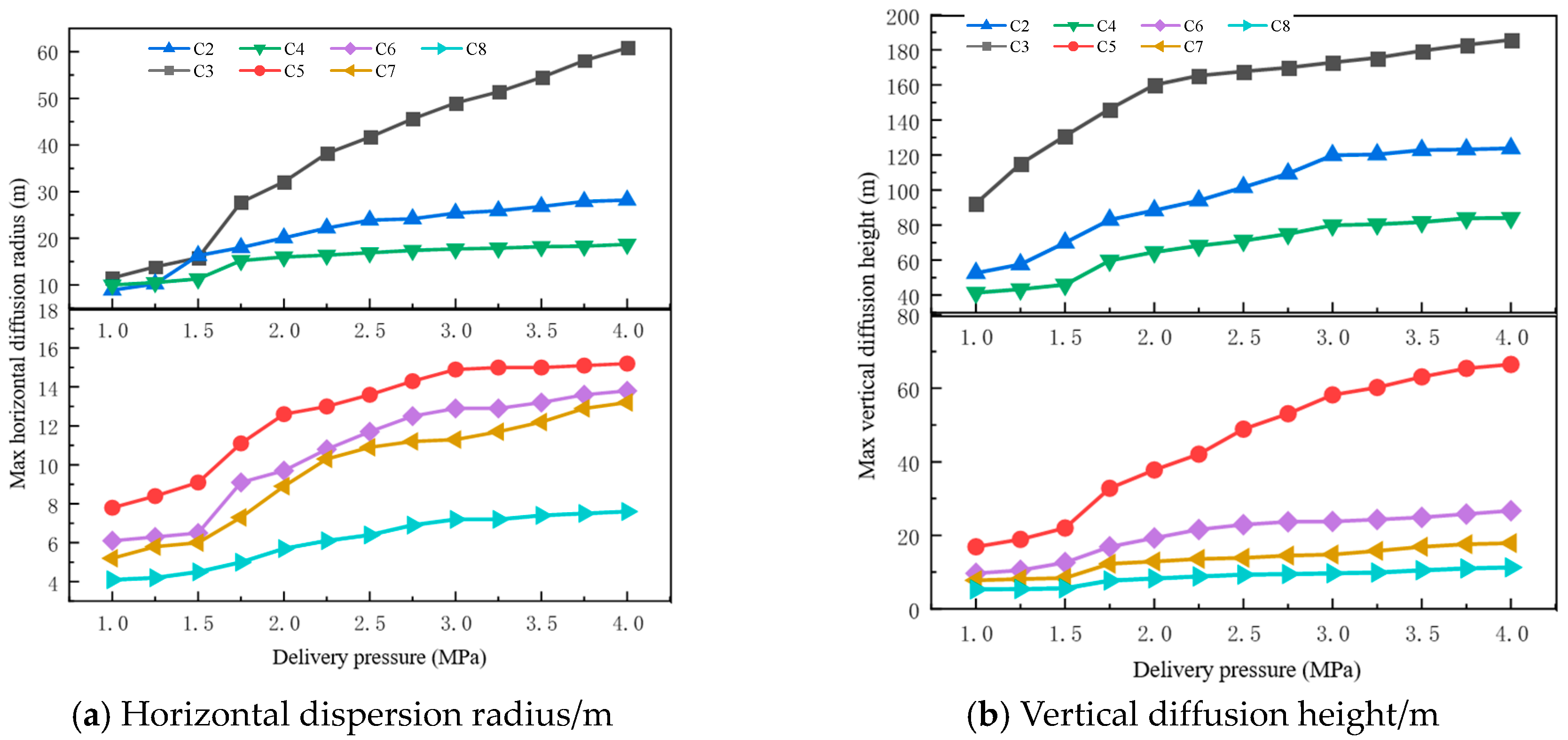
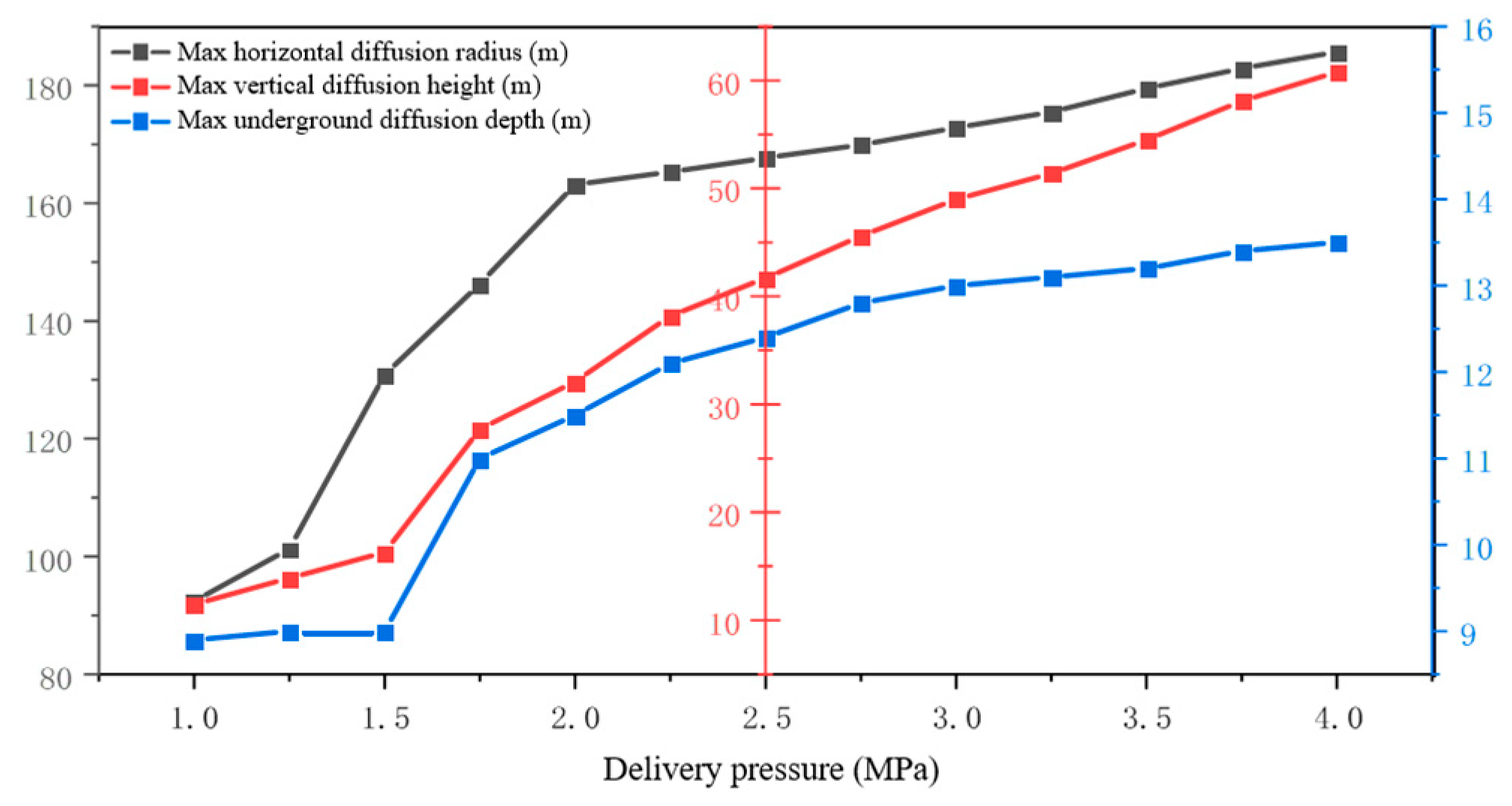
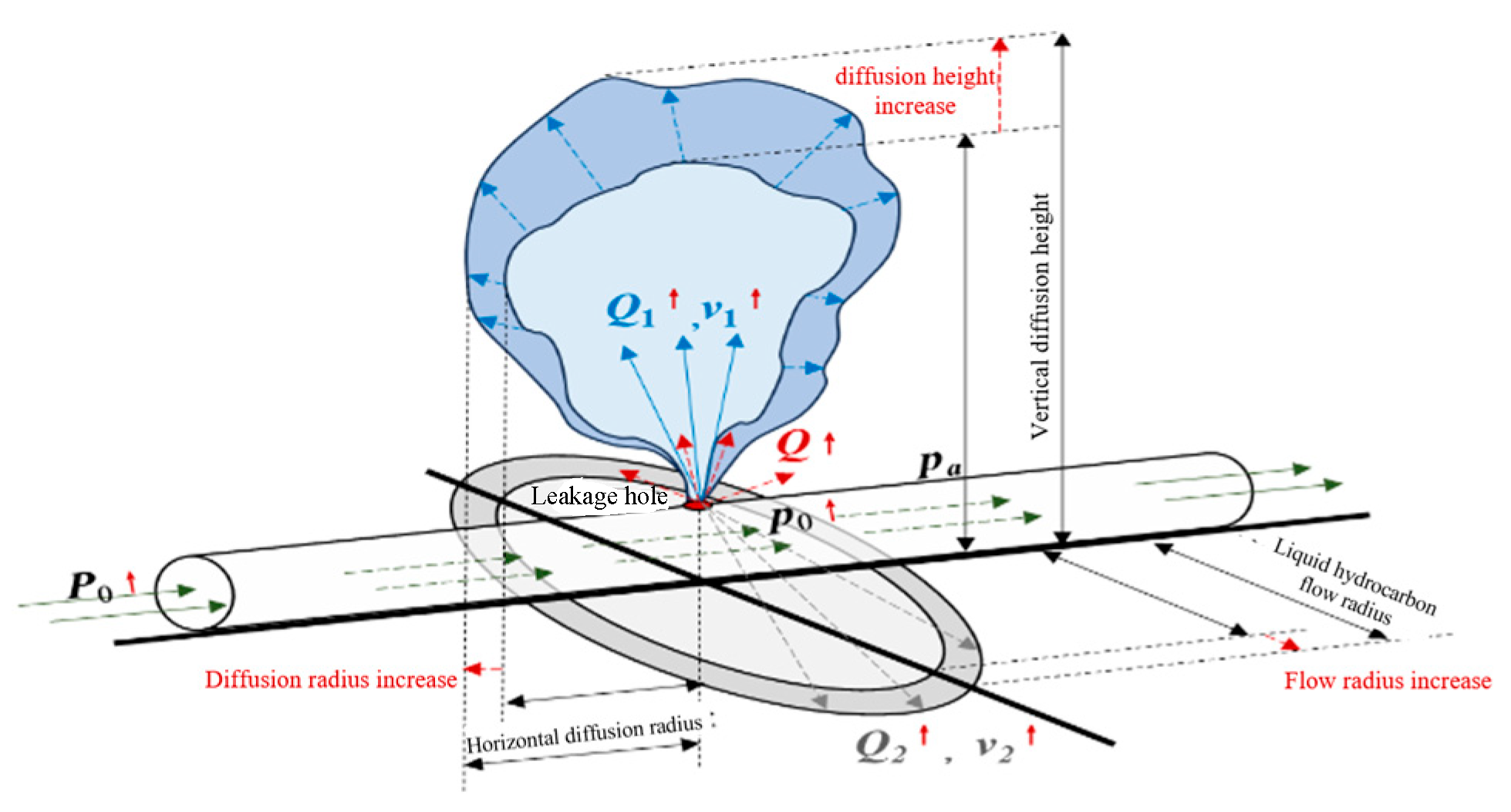
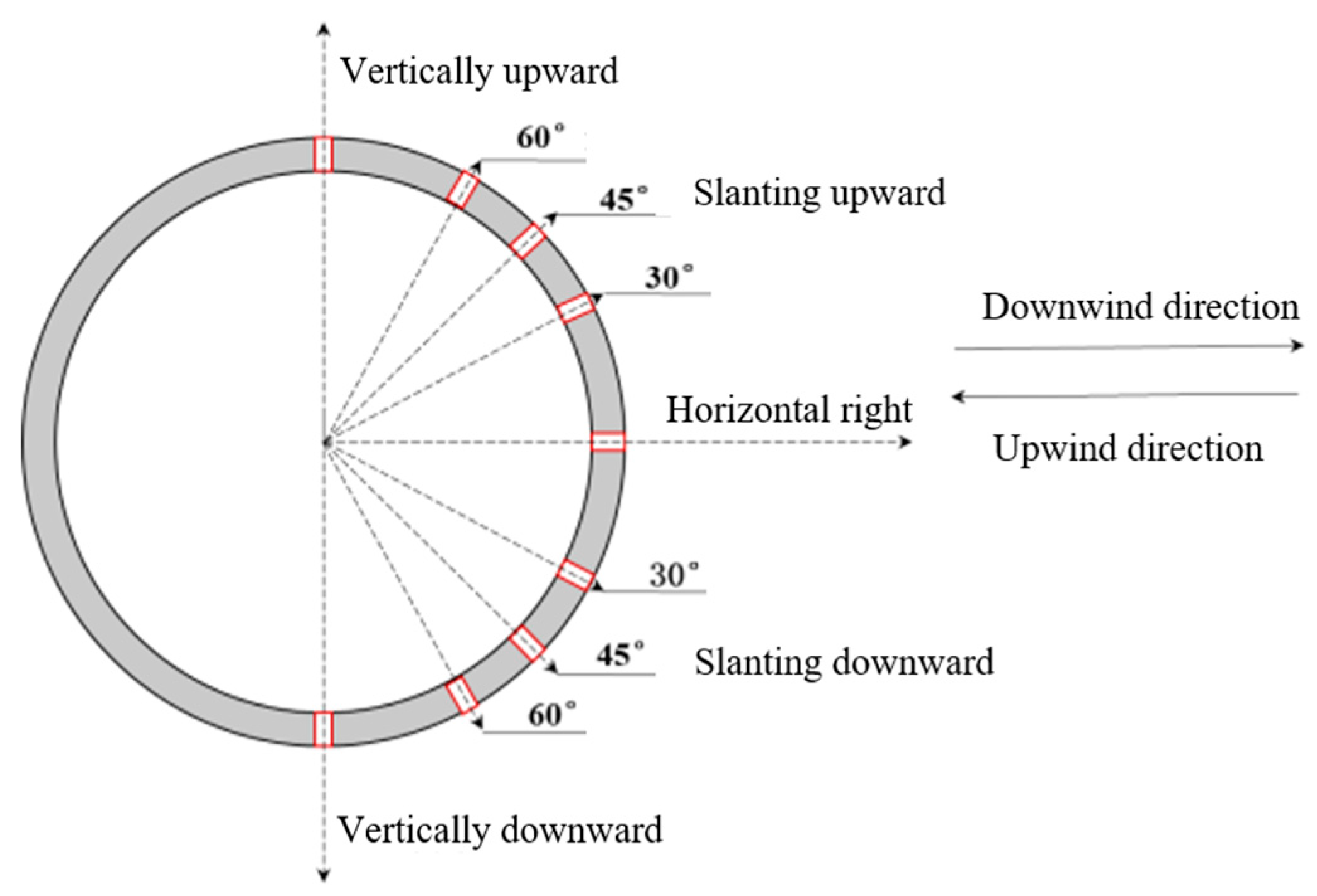
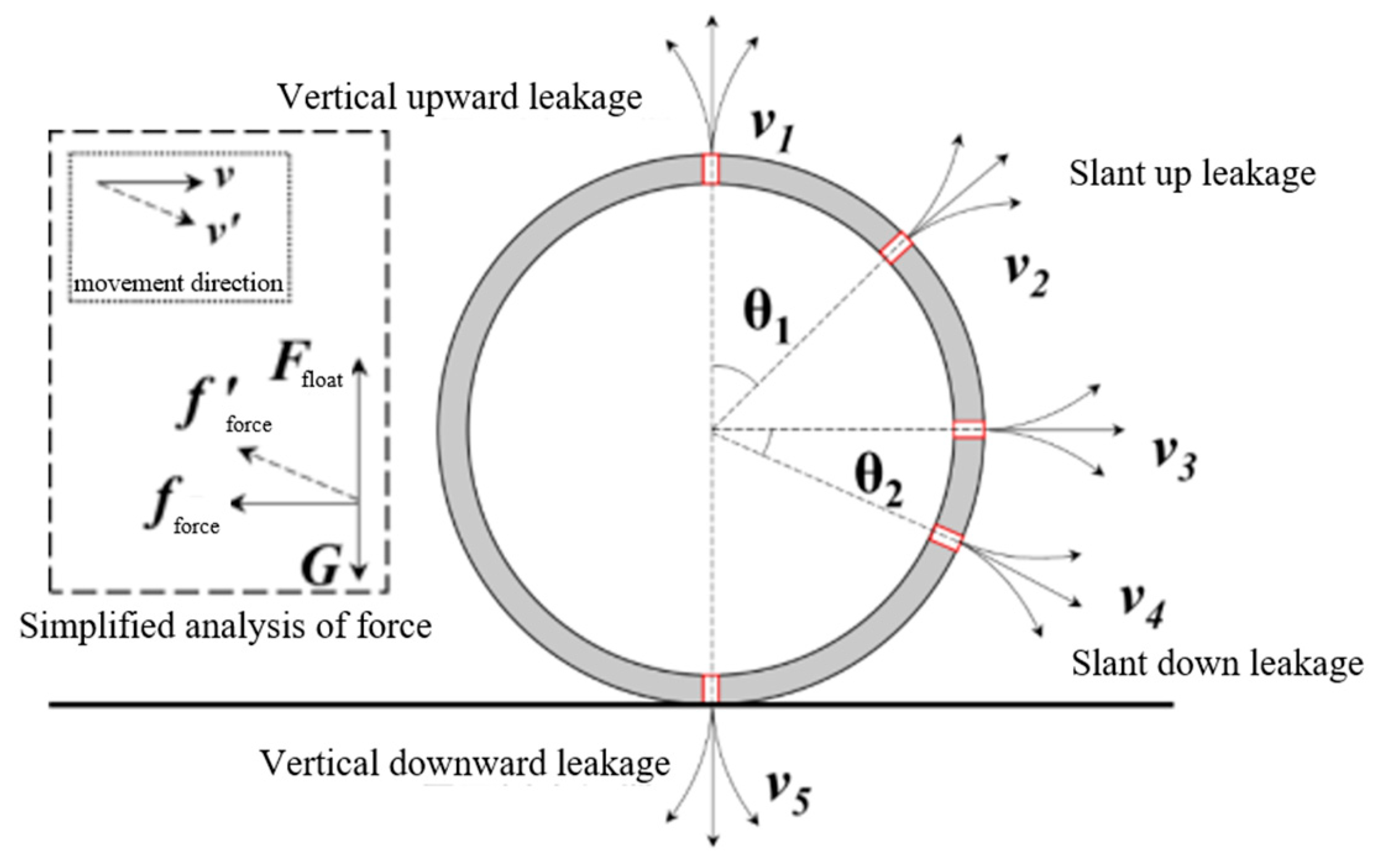

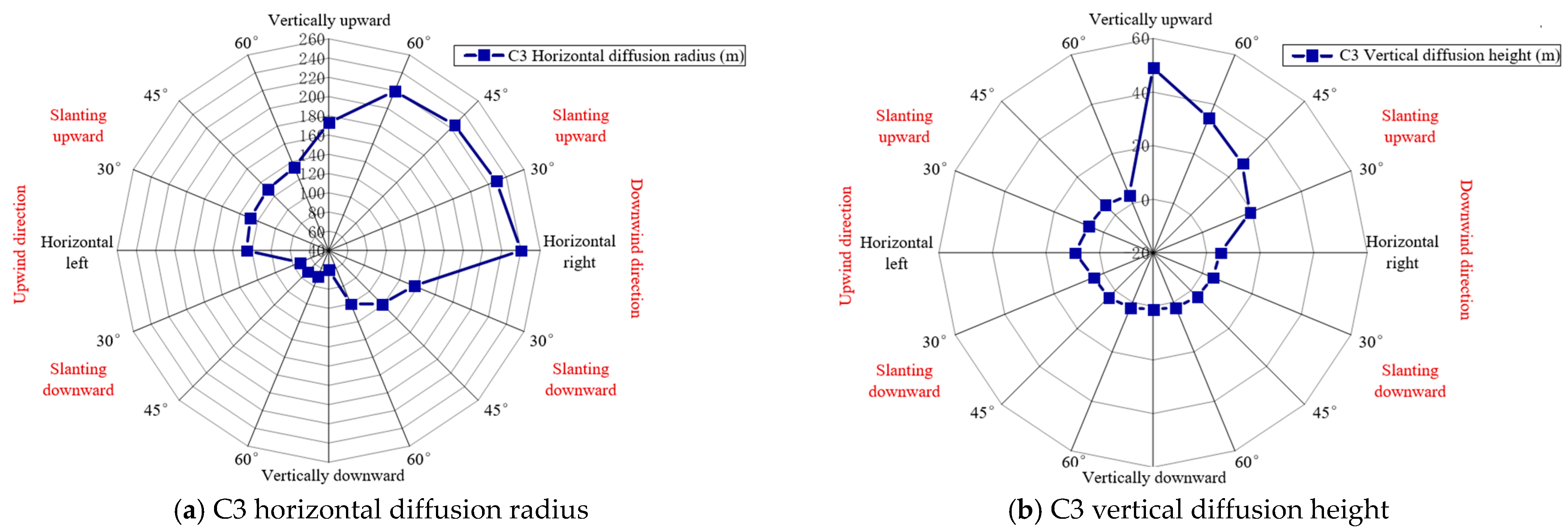



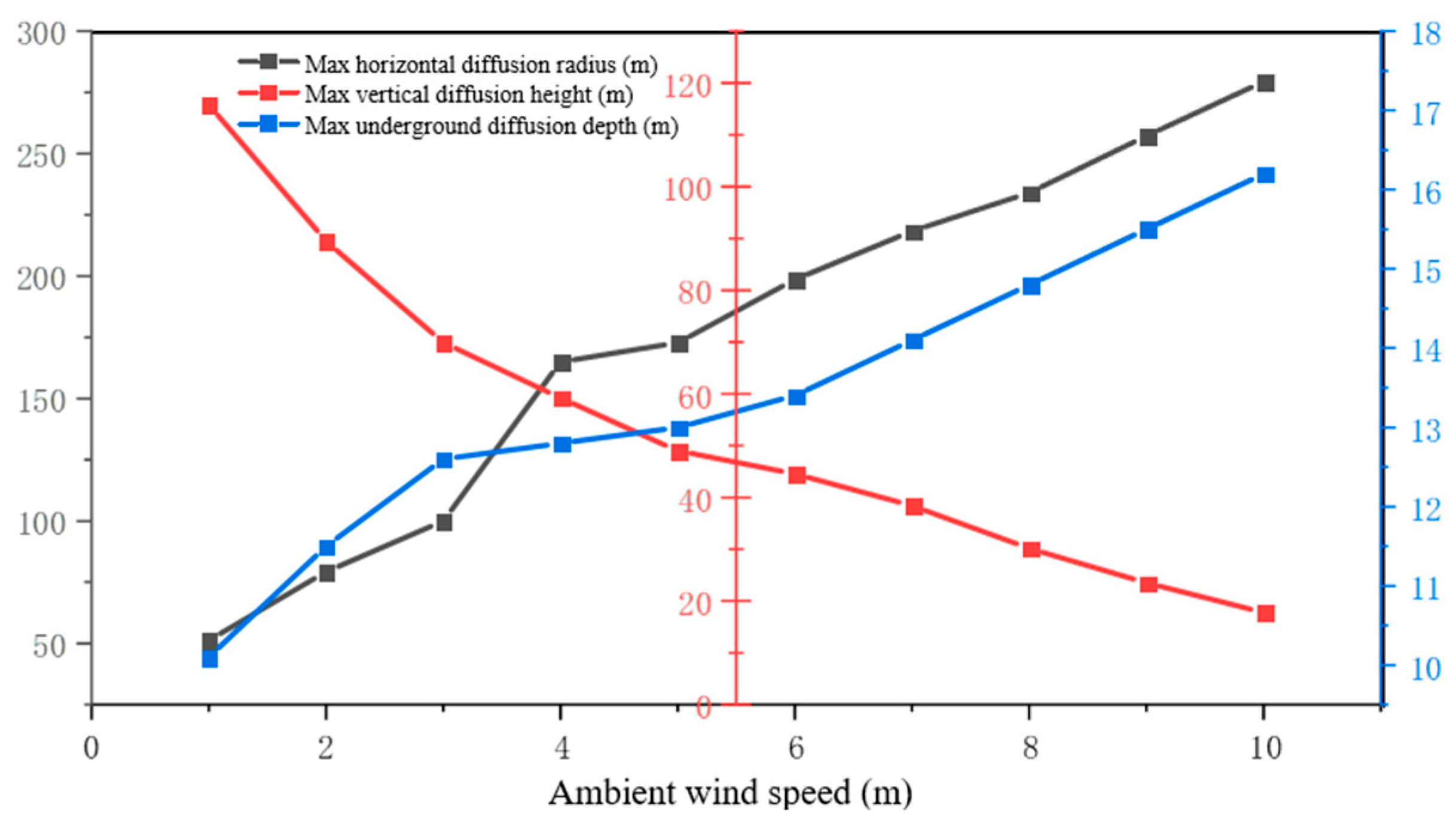
| Major Categories | Representative Failure Factors |
|---|---|
| Corrosion (chemical degradation) | Internal corrosion, external corrosion, and unknown type |
| Excavation damage | Operator/contractor excavation, third-party excavation, and unknown type |
| Mishandling | Operator/contractor operator error, incorrect installation, other incorrect operation, and unknown type |
| Material/welding/equipment failure | Pipe body, pipe welds, mechanical fits, joint/component failures, control/rescue equipment failures, coupling failures, assembly issues, and unknown types |
| Natural forces | Earth movement, flooding, lightning, temperature extremes, wind, and unknown type |
| Other external damage | Fire/explosion, continued excavation activities, mechanical damage, vandalism, and unknown |
| Other causes | Mixed causes and unknown causes |
| Serial No. | Pipeline Pressure (MPa) | Pipe Temperature (K) | Leakage Aperture (mm) | Orifice Shape | Total Mass Flow Rate (Experimental) (kg/s) | Total Mass Flow Rate (Simulated) (kg/s) | Error (%) |
|---|---|---|---|---|---|---|---|
| 1 | 2.12 | 290 | 51 | Round hole | 9.5 | 10.24 | 8.39 |
| 2 | 2.25 | 291.55 | 35 | Round hole | 4.8 | 5.06 | 7.82 |
| 3 | 1.16 | 286.95 | 51 | Round hole | 6.0 | 5.44 | 6.50 |
| 4 | 2.18 | 286.45 | 15 | Rectangular hole | 1.35 | 1.44 | 9.31 |
| Parameter Name | Unit | Retrieve a Value | Parameter Name | Unit | Retrieve a Value | ||
|---|---|---|---|---|---|---|---|
| Light hydrocarbon fraction | % | C2 | 10 | Pipe diameter/wall thickness | mm | 244.5 mm/10 mm | |
| C3 | 30 | Operating pressure | MPa | 3.0 | |||
| C4 | 20 | Leakage aperture | mm | 20 | |||
| C5 | 20 | Orifice direction | Vertically | ||||
| C6 | 10 | Soil properties | Porosity | 0.3 | |||
| C7 | 5 | mm | Particle diameter | 0.25 | |||
| C8 | 5 | m−1 | Inertial drag | 6.56 × 105 | |||
| Pipe temperature | °C | 25 | m−2 | Viscous drag | 3.38 × 1011 | ||
| Environmental temperature | °C | 25 | Ambient air velocity | m/s | 5.0 | ||
| Light Hydrocarbon | C2 | C3 | C4 | C5 | C6 | C7 | C8 |
|---|---|---|---|---|---|---|---|
| Concentration of concern | 3.0% | 2.2% | 1.8% | 1.1% | 1.2% | 1.1% | 1.0% |
| Parameter Name | Unit | Retrieve a Value | Parameter Name | Unit | Retrieve a Value | ||
|---|---|---|---|---|---|---|---|
| Light hydrocarbon fraction | % | C2 | 10 | Pipe diameter/wall thickness | mm | 244.5 mm/10 mm | |
| C3 | 30 | Operating pressure | MPa | 3.0 | |||
| C4 | 20 | Leakage aperture | mm | 20 | |||
| C5 | 20 | Orifice direction | Vertically | ||||
| C6 | 10 | Soil properties | Porosity | 0.3 | |||
| C7 | 5 | mm | Particle diameter | 0.25 | |||
| C8 | 5 | m−1 | Inertial drag | 6.56 × 105 | |||
| Pipe temperature | °C | 25 | m−2 | Viscous drag | 3.38 × 1011 | ||
| Environmental temperature | °C | 25 | Ambient air velocity | m/s | 5.0 | ||
Disclaimer/Publisher’s Note: The statements, opinions and data contained in all publications are solely those of the individual author(s) and contributor(s) and not of MDPI and/or the editor(s). MDPI and/or the editor(s) disclaim responsibility for any injury to people or property resulting from any ideas, methods, instructions or products referred to in the content. |
© 2025 by the authors. Licensee MDPI, Basel, Switzerland. This article is an open access article distributed under the terms and conditions of the Creative Commons Attribution (CC BY) license (https://creativecommons.org/licenses/by/4.0/).
Share and Cite
Zhang, S.; Xia, X.; Deng, Y.; Han, X.; Deng, B.; Liu, H.; Yan, X.; Chen, L. Investigating Light Hydrocarbon Pipeline Leaks: A Comprehensive Study on Diffusion Patterns and Energy Safety Implications. Energies 2025, 18, 3151. https://doi.org/10.3390/en18123151
Zhang S, Xia X, Deng Y, Han X, Deng B, Liu H, Yan X, Chen L. Investigating Light Hydrocarbon Pipeline Leaks: A Comprehensive Study on Diffusion Patterns and Energy Safety Implications. Energies. 2025; 18(12):3151. https://doi.org/10.3390/en18123151
Chicago/Turabian StyleZhang, Shuxin, Xiaohui Xia, Yufa Deng, Xiaochun Han, Banghui Deng, Huituan Liu, Xi Yan, and Liqiong Chen. 2025. "Investigating Light Hydrocarbon Pipeline Leaks: A Comprehensive Study on Diffusion Patterns and Energy Safety Implications" Energies 18, no. 12: 3151. https://doi.org/10.3390/en18123151
APA StyleZhang, S., Xia, X., Deng, Y., Han, X., Deng, B., Liu, H., Yan, X., & Chen, L. (2025). Investigating Light Hydrocarbon Pipeline Leaks: A Comprehensive Study on Diffusion Patterns and Energy Safety Implications. Energies, 18(12), 3151. https://doi.org/10.3390/en18123151





